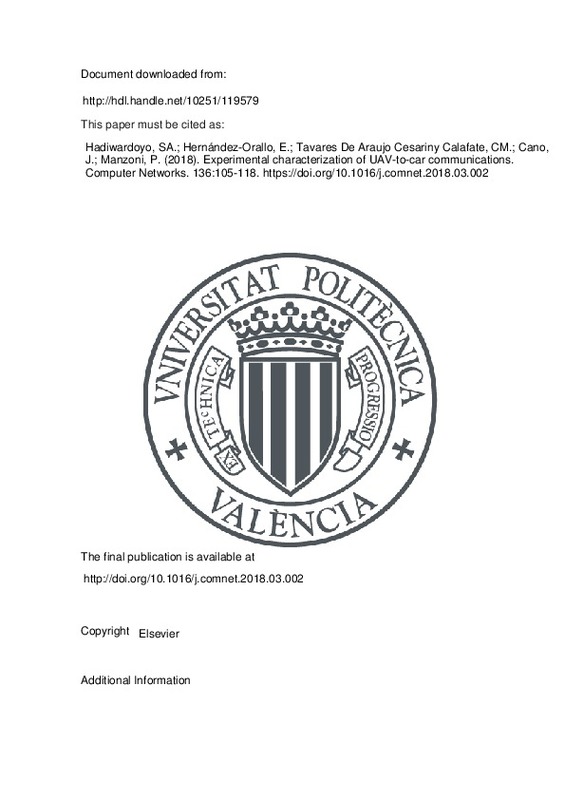JavaScript is disabled for your browser. Some features of this site may not work without it.
Buscar en RiuNet
Listar
Mi cuenta
Estadísticas
Ayuda RiuNet
Admin. UPV
Experimental characterization of UAV-to-car communications
Mostrar el registro sencillo del ítem
Ficheros en el ítem
| dc.contributor.author | Hadiwardoyo, Seilendria Ardityarama
|
es_ES |
| dc.contributor.author | Hernández-Orallo, Enrique
|
es_ES |
| dc.contributor.author | Tavares De Araujo Cesariny Calafate, Carlos Miguel
|
es_ES |
| dc.contributor.author | Cano, Juan-Carlos
|
es_ES |
| dc.contributor.author | Manzoni, Pietro
|
es_ES |
| dc.date.accessioned | 2019-04-25T20:02:25Z | |
| dc.date.available | 2019-04-25T20:02:25Z | |
| dc.date.issued | 2018 | es_ES |
| dc.identifier.issn | 1389-1286 | es_ES |
| dc.identifier.uri | http://hdl.handle.net/10251/119579 | |
| dc.description.abstract | [EN] Unmanned Aerial Vehicles (UAVs), popularly known as drones, can be deployed in conjunction with a network of ground vehicles. In situations where no infrastructure is available, drones can be deployed as mobile infrastructure elements to offer all types of services. Examples of such services include safety in rural areas where, upon an emergency event, drones can be quickly deployed as information relays for distributing critical warning to vehicles. In this work, we analyze the communications performance on the link between cars and drones taking into account the altitude, the antenna orientation, and the relative distance. The presented results show that the communication between a drone and a car can reach up to three kilometers in a rural area, and achieves at least a fifty percent success ratio for the delivery rate at a 2.7 km range. Finally, to allow integrating the communications link behaviour in different network simulators, the experimental results were also modeled with a modified Gaussian function that offers a suitable representation for this kind of communication. | es_ES |
| dc.description.sponsorship | This work was partially supported by the "Ministerio de Economia y Competividad, Programa Estatal de Investigacion, Desarollo e Innovacion Orientada a los Retos de la Sociedad, Proyectos I+D+I 2014", Spain, under grants TEC2014-52690-R and BES-2015-075988. | |
| dc.language | Inglés | es_ES |
| dc.publisher | Elsevier | es_ES |
| dc.relation.ispartof | Computer Networks | es_ES |
| dc.rights | Reconocimiento - No comercial - Sin obra derivada (by-nc-nd) | es_ES |
| dc.subject | VANET | es_ES |
| dc.subject | ITS | es_ES |
| dc.subject | UAV | es_ES |
| dc.subject | GRCBox | es_ES |
| dc.subject | Real implementation | es_ES |
| dc.subject.classification | ARQUITECTURA Y TECNOLOGIA DE COMPUTADORES | es_ES |
| dc.title | Experimental characterization of UAV-to-car communications | es_ES |
| dc.type | Artículo | es_ES |
| dc.identifier.doi | 10.1016/j.comnet.2018.03.002 | es_ES |
| dc.relation.projectID | info:eu-repo/grantAgreement/MINECO//BES-2015-075988/ES/BES-2015-075988/ | es_ES |
| dc.relation.projectID | info:eu-repo/grantAgreement/MINECO//TEC2014-52690-R/ES/INTEGRACION DEL SMARTPHONE Y EL VEHICULO PARA CONECTAR CONDUCTORES, SENSORES Y ENTORNO A TRAVES DE UNA ARQUITECTURA DE SERVICIOS FUNCIONALES/ | es_ES |
| dc.rights.accessRights | Abierto | es_ES |
| dc.date.embargoEndDate | 2020-05-08 | es_ES |
| dc.contributor.affiliation | Universitat Politècnica de València. Departamento de Informática de Sistemas y Computadores - Departament d'Informàtica de Sistemes i Computadors | es_ES |
| dc.description.bibliographicCitation | Hadiwardoyo, SA.; Hernández-Orallo, E.; Tavares De Araujo Cesariny Calafate, CM.; Cano, J.; Manzoni, P. (2018). Experimental characterization of UAV-to-car communications. Computer Networks. 136:105-118. https://doi.org/10.1016/j.comnet.2018.03.002 | es_ES |
| dc.description.accrualMethod | S | es_ES |
| dc.relation.publisherversion | http://doi.org/10.1016/j.comnet.2018.03.002 | es_ES |
| dc.description.upvformatpinicio | 105 | es_ES |
| dc.description.upvformatpfin | 118 | es_ES |
| dc.type.version | info:eu-repo/semantics/publishedVersion | es_ES |
| dc.description.volume | 136 | es_ES |
| dc.relation.pasarela | S\355530 | es_ES |
| dc.contributor.funder | Ministerio de Economía, Industria y Competitividad | es_ES |







![[Cerrado]](/themes/UPV/images/candado.png)

